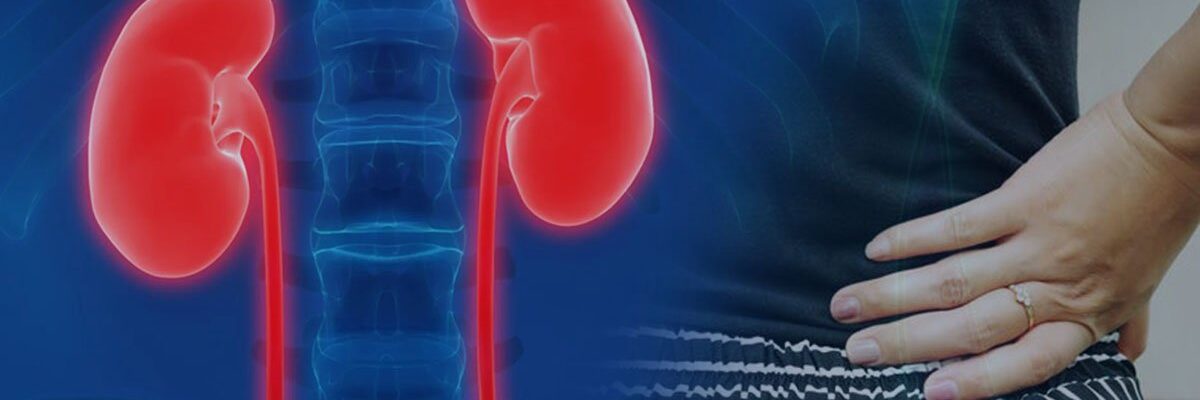Summary
A kidney infection, also known as pyelonephritis, occurs when bacteria infect one or both kidneys. This condition often develops from an untreated urinary tract infection (UTI), where bacteria that initially affect the bladder travel up to the kidneys, leading to a more severe infection.
The symptoms of a kidney infection are similar to those of a UTI but are generally more intense. Patients may experience pain during urination, cloudy or yellowish urine, and discomfort in the lower back or sides (flank pain).
To treat a kidney infection, doctors typically prescribe antibiotics to eliminate the infection. In more severe cases, hospitalization may be necessary, allowing intravenous antibiotics to be administered directly. Timely treatment is essential to prevent complications and protect kidney function.
Table of Contents
Symptoms of Kidney Infection

As previously mentioned, the symptoms of a kidney infection closely resemble those of a urinary tract infection (UTI) but are often more severe. A person may have a kidney infection if they experience the following symptoms:
- Painful urination. Discomfort or pain while urinating is common in kidney infections due to inflammation in the urinary tract.
- Cloudy and yellowish urine. The presence of bacteria or pus in the urine can cause it to appear cloudy or unusually dark.
- Presence of pus or blood in the urine. Severe kidney infections may cause visible pus or blood, turning the urine pink or red.
- Back or side (flank) pain. Pain in the lower back or side, particularly near the kidneys, is a key symptom of kidney infection and often differentiates it from a lower urinary tract infection.
- Frequent urination. The urge to urinate frequently, even if the bladder is not full, is a common symptom of infection.
- Feeling of needing to urinate right after urinating. Patients often feel a persistent urge to urinate, even immediately after emptying their bladder.
- Foul-smelling urine. The presence of bacteria and infection in the kidneys can lead to an unusual and strong odor in the urine.
- Fever. Fever is a typical sign of infection as the immune system works to fight the bacteria in the kidneys.
- Nausea and vomiting. The buildup of toxins due to kidney infection can cause nausea and vomiting.
- Muscle chills. Chills or shivering often accompany fever as the body attempts to combat the bacterial infection.
A fever usually indicates that the immune system is actively fighting the bacteria causing the infection. Prompt medical attention is recommended for kidney infections to prevent further complications.
Types of Kidney Infection
Kidney infections, or pyelonephritis, can be classified into different types based on the nature of the infection and its progression:
- Acute Pyelonephritis. This is the most common form of kidney infection and occurs suddenly. Acute pyelonephritis typically results from bacteria, such as E. coli, traveling up from the bladder into one or both kidneys. Symptoms include fever, chills, back pain, and painful urination. It often requires immediate treatment with antibiotics to prevent complications.
- Chronic Pyelonephritis. Chronic pyelonephritis is a long-term infection that recurs or persists over time, often due to underlying issues such as urinary tract blockages, vesicoureteral reflux (a condition where urine flows backward into the kidneys), or untreated acute infections. Chronic infections can cause progressive scarring in the kidneys, potentially leading to chronic kidney disease if not managed properly.
- Emphysematous Pyelonephritis. This rare but severe form of kidney infection involves gas-forming bacteria that create gas bubbles in kidney tissues. Emphysematous pyelonephritis primarily affects individuals with diabetes and can lead to kidney tissue destruction. It often requires aggressive treatment, including antibiotics and sometimes surgery, to remove infected tissue.
- Xanthogranulomatous Pyelonephritis. A chronic form of kidney infection, xanthogranulomatous pyelonephritis is characterized by the destruction of kidney tissue and the formation of granulomas (small nodules). This condition is often associated with kidney stones and long-standing urinary obstructions. It typically requires surgical intervention and may involve partial or complete removal of the affected kidney.
- Complicated Pyelonephritis. Complicated kidney infections occur in individuals with structural abnormalities in the urinary tract, weakened immune systems, or underlying health conditions such as diabetes. These infections tend to be more difficult to treat and may require longer courses of antibiotics, hospitalization, or surgical interventions.
- Uncomplicated Pyelonephritis. Uncomplicated kidney infections occur in otherwise healthy individuals and typically result from a straightforward bacterial infection without underlying structural issues. This type usually responds well to antibiotic treatment and does not often lead to severe complications if treated promptly.
Recognizing the type of kidney infection is essential for effective treatment. While acute cases may resolve with antibiotics, chronic or complicated infections often require a combination of antibiotics and, in severe cases, surgical intervention to prevent further kidney damage.
Diagnostic Procedures for Kidney Infection
Diagnosing a kidney infection involves several tests to confirm infection, determine its severity, and identify any underlying issues. Here are the primary diagnostic procedures for kidney infections:
- Urinalysis. A urinalysis is often the first test used to detect infection, identifying white blood cells, red blood cells, and bacteria in the urine. This test helps differentiate a kidney infection from other urinary tract issues.
- Urine Culture. A urine culture identifies the specific bacteria causing the infection. This information is essential for selecting the most effective antibiotic treatment to clear the infection.
- Blood Tests. Blood tests, including a complete blood count (CBC) and blood culture, help assess the severity of the infection and detect if it has spread to the bloodstream. Elevated white blood cell counts indicate the body is fighting an infection.
- Imaging Studies. Imaging tests such as ultrasound or CT scan may be ordered to assess for complications, such as kidney stones, blockages, or abscesses, which may contribute to or worsen the infection.
- Voiding Cystourethrogram (VCUG). In cases of recurrent kidney infections, this X-ray test may be used to evaluate bladder and urethra function. A VCUG helps detect vesicoureteral reflux, a condition where urine flows backward from the bladder to the kidneys, increasing infection risk.
- Renal Scintigraphy (DMSA Scan). This nuclear medicine scan provides detailed images of the kidneys to check for scarring or structural damage from previous infections. It’s commonly used in children with frequent kidney infections.
These diagnostic procedures provide essential information, helping healthcare providers confirm a kidney infection, determine the most effective treatment, and address any underlying factors contributing to the infection.
Complications of Untreated Kidney Infection

If a kidney infection is left untreated, it can lead to serious and potentially life-threatening complications. These include:
- Chronic Kidney Disease (CKD). Recurrent or untreated kidney infections can cause lasting damage to kidney tissue, leading to scarring and a gradual decline in kidney function. Over time, this can progress to chronic kidney disease, affecting the body’s ability to filter waste and maintain fluid balance.
- Sepsis. When bacteria from a kidney infection enter the bloodstream, it can lead to sepsis, a life-threatening condition that causes widespread inflammation and organ failure. Sepsis requires immediate medical intervention to prevent severe outcomes.
- Kidney Abscesses. Untreated kidney infections can result in abscesses—pockets of pus that form within the kidneys. Abscesses can increase pressure on the kidneys, further compromising their function and may require drainage or surgery for treatment.
- High Blood Pressure. Kidney infections can lead to long-term high blood pressure due to scarring and damage to the kidney tissue. High blood pressure itself can also exacerbate kidney damage, creating a harmful cycle that can worsen kidney health.
- Acute Kidney Failure. In severe cases, untreated kidney infections can cause sudden loss of kidney function, known as acute kidney failure. This condition is marked by a dangerous buildup of toxins in the bloodstream and often requires dialysis to temporarily replace kidney function.
- Pyonephrosis. This rare but serious complication occurs when pus fills the kidney, obstructing urine flow. Pyonephrosis can lead to severe pain, fever, and the need for emergency surgical drainage to remove the infected fluid.
Prompt treatment of kidney infections is crucial to prevent these complications, ensuring better long-term kidney health and overall well-being.
Causes of Kidney Infection
Kidney infections, or pyelonephritis, can have various causes. They commonly occur when E. coli bacteria enter the kidneys. E. coli bacteria naturally reside in the intestines, where they are generally harmless. However, if E. coli bacteria reach the kidneys, they can lead to infection. These bacteria can enter the kidneys through the following ways:
- Untreated Urinary Tract Infection (UTI). UTIs are the primary cause of kidney infections. If a UTI is not properly treated, bacteria from the bladder can travel upward, eventually reaching the kidneys and causing infection.
- Kidney stones. Even without a UTI, kidney infections can occur if the patient has kidney stones. These stones are mineral deposits that form in the kidneys due to factors like high salt intake, dehydration, and poor diet. The stones can obstruct urine flow, creating an environment where bacteria can thrive and lead to infection.
- Improper hygiene after bowel movements. E. coli bacteria reside in the intestines and are excreted through stool. If the genital area is not properly cleaned after a bowel movement, bacteria can enter the urinary tract and travel up to the kidneys.
- Frequent sexual activity. Engaging in sexual activity frequently can increase the risk of bacteria entering the urinary tract, especially if multiple partners are involved, as it can introduce foreign bacteria into the system.
- Use of a urinary catheter. A urinary catheter is a small tube inserted into the bladder to drain urine when a patient cannot urinate independently, often post-surgery or during unconsciousness. If the catheter is not regularly replaced, it can become a breeding ground for bacteria, which can travel to the kidneys and cause infection.
Understanding these causes can help in taking preventive measures, such as treating UTIs promptly, maintaining proper hygiene, and ensuring catheter care, to reduce the risk of kidney infection.
Prevention of Kidney Infection

Kidney infections can be prevented with the following precautions to reduce the risk of infection:
- Do not hold in urine. Avoid delaying urination, as this can allow bacteria to remain in the bladder longer. Ensure that the bladder is fully emptied without rushing.
- Urinate after sexual activity. Urinating after intercourse helps flush out bacteria that may have entered the urethra. Additionally, wash the genital area to remove any bacteria that could lead to infection.
- Drink at least 8 glasses of water daily. Staying hydrated encourages regular urination, which helps flush out bacteria from the urinary tract.
- For women, wipe from front to back. This prevents bacteria from the anus from contaminating the urethra and bladder, reducing the risk of urinary tract infections.
- Avoid using deodorant sprays and douches. These products can irritate the genital area, potentially disrupting the natural balance of bacteria and increasing the risk of infection.
By following these preventive measures, individuals can lower their chances of developing kidney infections and maintain urinary tract health.
Risk Factors for Kidney Infection
Kidney infections can affect anyone, but certain factors increase the likelihood of developing this condition:
- Being female. Women are more susceptible to kidney infections because they have a shorter urethra, which allows bacteria to reach the bladder and kidneys more easily.
- Sexual activity. Frequent sexual activity increases the risk of bacteria entering the urinary tract, especially if proper hygiene is not practiced after intercourse or if a partner has poor hygiene.
- Existing urinary system issues. Individuals with urinary tract obstructions, nerve damage affecting the bladder, or vesicoureteral reflux (where urine flows back into the bladder and kidneys) have a higher risk of developing kidney infections.
- Weakened immune system. A weakened immune system makes the body more susceptible to infections, as it may be less effective in fighting off invading bacteria.
Recognizing these risk factors is essential for prevention, especially for those at higher risk. Good hygiene practices and prompt treatment of any urinary issues can help reduce the risk of kidney infections.
Kidney Infection FAQs
Kidney infections, or pyelonephritis, are serious bacterial infections that affect the kidneys and can lead to severe complications if left untreated. Understanding the causes, symptoms, and treatment options for kidney infections is essential for prompt management and prevention. Below are answers to frequently asked questions to help you better understand this condition and take the necessary steps to protect your health.
- What is a kidney infection?
A kidney infection, also known as pyelonephritis, is a type of urinary tract infection (UTI) that occurs when bacteria travel to the kidneys, causing inflammation and infection. - What are the common symptoms of a kidney infection?
Symptoms include back or side pain, fever, chills, frequent urination, painful urination, blood or pus in the urine, and nausea or vomiting. - What causes a kidney infection?
Kidney infections are typically caused by bacteria, often E. coli, that enter through the urethra and travel up to the bladder and kidneys. Risk factors include untreated UTIs, kidney stones, or structural abnormalities in the urinary tract. - How is a kidney infection diagnosed?
Doctors diagnose kidney infections through a combination of physical exams, urine tests (to detect bacteria and white blood cells), and imaging tests like ultrasounds or CT scans if necessary. - What are the risks of not treating a kidney infection?
Untreated kidney infections can lead to serious complications, such as permanent kidney damage, sepsis (a life-threatening infection), or the spread of infection to other parts of the body. - Who is at higher risk of developing a kidney infection?
People with frequent UTIs, kidney stones, diabetes, weakened immune systems, or structural abnormalities in the urinary tract are at higher risk. Pregnant women and individuals with catheters are also more susceptible. - How is a kidney infection treated?
Treatment typically involves antibiotics to eliminate the infection. Severe cases may require hospitalization for intravenous antibiotics and fluids. Addressing underlying causes, like kidney stones, may also be necessary. - Can kidney infections be prevented?
Yes, by drinking plenty of water, urinating after sexual activity, maintaining proper hygiene, and treating UTIs promptly. Avoiding excessive use of irritants like douches or harsh soaps can also help. - Are kidney infections contagious?
No, kidney infections are not contagious. They result from bacteria that naturally exist in or enter the urinary tract and are not spread from person to person. - When should I see a doctor for a suspected kidney infection?
Seek medical attention immediately if you experience severe symptoms like high fever, intense back or side pain, nausea, vomiting, or blood in your urine. Early treatment is crucial to prevent complications.
These FAQs provide an overview of kidney infections, their symptoms, causes, and treatments, helping individuals better understand and manage this condition.


